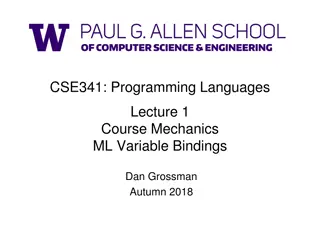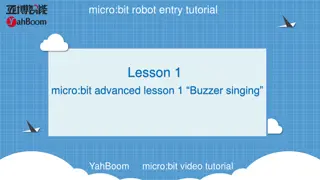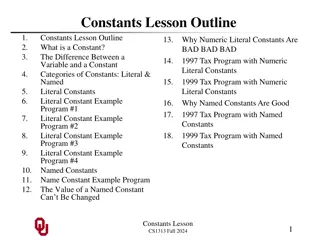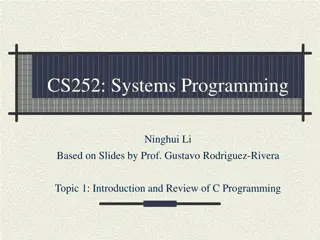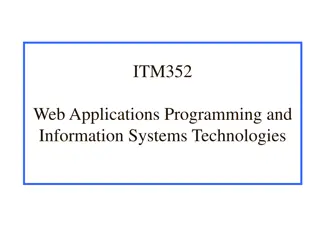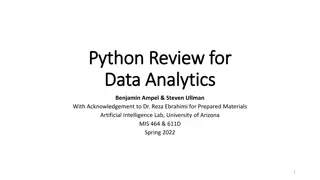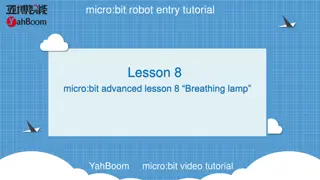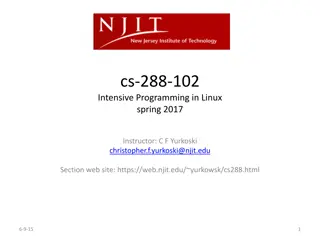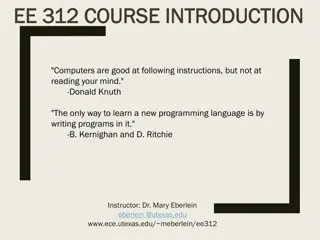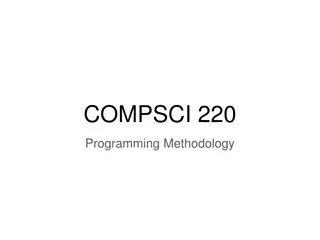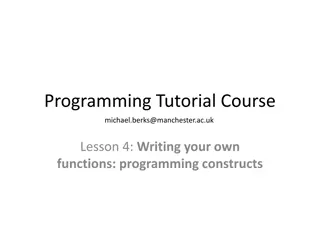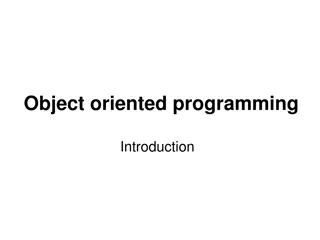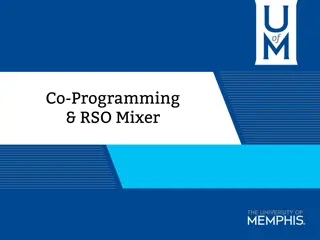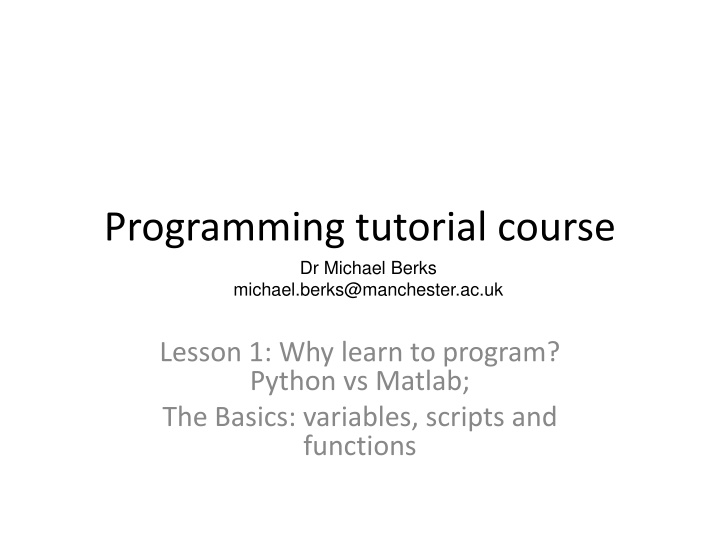
Learn Programming with Dr. Michael Berks: Basics and Importance
Discover the significance of learning programming with Dr. Michael Berks in this introductory tutorial course. Differentiate between Python and Matlab, understand the essentials of variables, scripts, and functions. Explore the definition and applications of computer programs, programming languages, and code in the field of medical imaging.
Uploaded on | 2 Views
Download Presentation

Please find below an Image/Link to download the presentation.
The content on the website is provided AS IS for your information and personal use only. It may not be sold, licensed, or shared on other websites without obtaining consent from the author. If you encounter any issues during the download, it is possible that the publisher has removed the file from their server.
You are allowed to download the files provided on this website for personal or commercial use, subject to the condition that they are used lawfully. All files are the property of their respective owners.
The content on the website is provided AS IS for your information and personal use only. It may not be sold, licensed, or shared on other websites without obtaining consent from the author.
E N D
Presentation Transcript
Programming tutorial course Dr Michael Berks michael.berks@manchester.ac.uk Lesson 1: Why learn to program? Python vs Matlab; The Basics: variables, scripts and functions
Why do I need to learn it ? What is Matlab? What is python? Because the course leader said so
What is Matlab/python? What is a computer program? What does computer programming mean? What is a programming language? What is code?
What is a computer program? Something you use to achieve some task on a computer (or phone, tablet etc) Word Write a letter, essay, lab report etc Excel Analyse results, produce graphs for your report etc Angry Birds Kill time when you re sitting in boring programming lectures
What is a computer program? In medical imaging DATA PROGRAM RESULT Image(s) Hopefully clinically useful! Lab results Do something clever Patient data
What is a computer program? In medical imaging DATA PROGRAM RESULT Predict whether the patient has Alzheimer s Disease MR images of the brain Measure volume of grey/white matter
What is a computer program? In medical imaging DATA PROGRAM RESULT Predict risk of developing breast cancer Mammogram acquired during routine screening + patient data Measure amount dense breast tissue
What is a computer program? In medical imaging DATA PROGRAM RESULT Tell doctor/drugs company if the drug is working MRI liver tumours before and after drug treatment Measure change in size of tumour
What does computer programming mean? Writing your own computer programs... telling the computer to do exactly what you want. What is a programming language? A way of translating human logic into commands a computer understands like human languages, there a lots of different languages (often similar to each other), each with a specific set of rules (syntax, grammar) to obey. A chunk of commands in a specific programming language What is code ? A program consists of bits of code put together in a logical way by using other people s code, you can incorporate bits of their program in your own (as long as you re using the same language!).
Now the big question. Why do I need to learn how to write my own computer code? Think of it like learning to cook ..
Go to a restaurant x x Get parents to cook x x x x You re hungry and want something good to eat .. Get a microwave meal
Heating someone elses food in the microwave Using a computer program Ok if they ve cooked exactly what you want Ok if it does exactly what you want Vs Vs Writing your own computer program Cooking your own food Can eat exactly as you like it Make it do exactly what you want Research is likely to be here
How good a cook/programmer do I need to be? Vs Do I need to write all my programs from scratch? No! Just like in cooking, you don t need make everything from raw ingredients, can use pre-made pasta, sauces, wine etc Remember you can use other people s code to include bits of their programs in yours but you do need to know the basics to put those bits together (how to chop an onion, when to add seasoning etc.)
And finally. What is Matlab? Matlab is both a program and a programming language ... it has lots of tools you can just use to analyse data and images. But you can also write code to extend it to do any analysis you like (although unlike a pure language, it will only work if the Matlab program is installed on the computer). Excel Photoshop Using other people s code Writing your own code + + + = A really powerful tool for imaging research!
But what about. Python? General purpose programming language Packages provide support for scientific computing Open-source
How does python differ from Matlab? It s free No need for an expensive license* Widely used, both in academia and industry Often installed as part of OS No single development environment This can make it a little trickier get started But, also more flexible We ll use Spyder on this course *Currently free because of COVID, but usually you have to pay for Matlab!
Course aims To show you how to use Matlab and/or python To introduce some basic programming ideas common to all programming languages To give examples of some tasks in medical imaging processing To provide code you can reuse later in your projects To make some pretty pictures!
Im a bit confused Should I use Matlab ..or Python?
For this course, consider Matlab and python as interchangeable you can use either or both. I will demonstrate mainly in Matlab, but everything we do will be very similar in both just watch out for the subtle differences!
vs If you see this I m referring to Matlab only If you see this I m referring to differences in python
First tasks Open Matlab (if you have it installed) Open Spyder (if you have it installed) Open a windows explorer window Go to the MScfolder you created for Professor s Cootes, maths course Make a new folder Programming Inside Programming, make new folders: Matlab Python Data TutorialSlides
First tasks Open an internet explorer/Google chrome window Go to the following webpage: http://personalpages.manchester.ac.uk/staff/michael.berks Click on the Matlab Tutorial tab Bookmark this page for future weeks Save the week 1 powerpoint slides and tutorial exercise into the TutorialSlides folder These will also be added to the Course content section of blackboard Leave the window open (we ll need it later) Open the lesson 1 powerpoint file you ve just saved As I m going through the slides, follow them on your computer
Lesson Overview Using the Matlab/Spyder interface Doing maths in the Command Window Assigning variables and suppressing visual output Collecting sequences of commands: scripts An introduction to functions Basic programming tips: expressive variable names and comments
Command window A fancy scientific calculator 2+3 2*3 2/3 2^3 Our first python difference! It s 2**3 in python 2^0.5 2+3*6/2 (2+3)*6/2 Try using and Select earlier expressions and edit them Any of the text in navy blue is code you can run in the command window. Try copy and pasting, then hitting return
Assigning Variables Use = to assign variables Keeps data in memory to use again a = 4 b = 3 + 6 y = (4*a^2 +3*b^3) / 5 Can also self-assign: b = b*2 Check the work space
Workspace Shows you what variables are currently stored in memory
Workspace Shows you what variables are currently stored in memory
Suppressing visual output Try a = rand(100) This creates a 100 x 100 matrix of random numbers Use clc to clear the Command Window Try a = rand(100);
Let's compute the number of seconds in a year Let's create some variables seconds_in_minute = 60 minutes_in_hour = 60 hours_in_day = 24 days_in_year = 365 Then compute: seconds_in_year = seconds_in_minute* minutes_in_hour*hours_in_day*days_in_year
Scripts Use clear to wipe the current memory Check that the workspace is now empty Click the New script button (top left of main menu) Opens a blank page in the editor Copy the previous commands to compute the number of seconds in a year from the Command History Paste them into the blank document Save the document as Matlab: programming_tutorial_lesson1_script.m Python: programming_tutorial_lesson1_script.py
Calling a script from the command-line Type: programming_tutorial_lesson1_script at the command line Note the lack of .m Check your work-space We'll look at different ways of calling python scripts in future lessons
How many seconds in 2 years? 10 years? N-years? Scripts are useful but if we want to re-run our script with different inputs, we should use a function
Matlab Functions In our script, type %% This creates a new cell a part of a script that can be run separately Now at the BOTTOM of the script function [seconds_in_n_years] = compute_seconds_in_years(n_years) seconds_in_minute = 60 minutes_in_hour = 60 hours_in_day = 24 days_in_year = 365 seconds_in_year = seconds_in_hour *hours_in_day*days_in_year seconds_in_n_years = n_years * seconds_in_year end Type another %% above the function, then compute_seconds_in_years(2)
Python Functions Again type %% Now type def compute_seconds_in_years(n_years) seconds_in_minute = 60 minutes_in_hour = 60 hours_in_day = 24 days_in_year = 365 seconds_in_year = seconds_in_hour *hours_in_day*days_in_year seconds_in_n_years = n_years * seconds_in_year return seconds_in_n_years Run this cell, no output is generated but the function is now available to use Type another %%, and then: compute_seconds_in_years(10)
vs What differences did you spot between the Matlab and python functions?
Inputs and output The variable n_years is an input to our function You will often see this described as an argument The variable seconds_in_n_years is the output of our function We look next at using multiple inputs We can also have multiple outputs but will see those in future lessons
Exercises Lookup Newton's law of universal gravitation (yes, you can use wikipedia) In Matlab, use the command prompt to compute the force of attraction between the moon and the earth You can assume Earth s mass: 5.97x1024 kg Moon s mass: 7.35x1022 kg Distance from earth to moon: 380,000km Gravitational constant: 6.674 10 11N m2kg 2 Rewrite this as a function that takes as input, M1, M2 and r Use commas to separate multiple inputs to your function Can we write this in python?
Variable, script and function names Must start with a letter Followed by any number of letters, digits, or underscores. Matlab and python are case sensitive A and a, my_fun and My_fun, etc are not the same name Certain keywords cannot be used if, for, end, etc Be expressive: try and use names that Describe what functions do Describe what variables are
Scripts summary Scripts allow us to run sequences of commands All data is stored in the main workspace, as if we typed the commands in the command window We can run parts of scripts by Selecting text and hitting F9 Using %% to create cells Even when hacking around use scripts, date tagged (e.g. work2013_02_11) to run commands That way you have a record of your work Think of them as your Matlab/Python lab book
Functions summary Functions group commands so that we can run them with different inputs We have looked at defining and calling functions inside scripts Next week we will look at how we can call functions from other places (hint: you've already done this!) Matlab and python have 1,000s of in-built functions, by learning how to call those we can create really powerful programs



